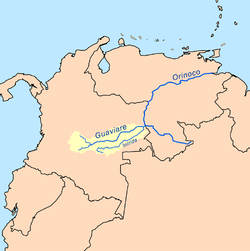| Guaviare | |
|---|---|
 The Guaviare River as seen from the air | |
 | |
| Location | |
| Country | Colombia |
| Physical characteristics | |
| Source | |
| • location | Confluence of Ariari and Guayabero Rivers |
| • coordinates | 2°34′52.9212″N 72°46′17.0328″W / 2.581367000°N 72.771398000°W |
| • elevation | 178 m (584 ft) |
| 2nd source | Ariari |
| • location | Cordillera Oriental |
| • coordinates | 3°54′31.698″N 74°6′30.2004″W / 3.90880500°N 74.108389000°W |
| • elevation | 4,040 m (13,250 ft) |
| 3rd source | Guayabero |
| • location | Cordillera Oriental |
| • coordinates | 3°31′36.5952″N 74°28′27.3684″W / 3.526832000°N 74.474269000°W |
| • elevation | 3,080 m (10,100 ft) |
| Mouth | |
• location | Orinoco |
• coordinates | 4°4′26.5656″N 67°43′14.8008″W / 4.074046000°N 67.720778000°W |
• elevation | 77 m (253 ft) |
| Length | Guaviare–Guayabero 1,760 km (1,090 mi)[1] |
| Basin size | 151,606.9 km2 (58,535.8 sq mi)[4] |
| Discharge | |
| • location | Near mouth |
| • average | (Period: 1926–2011)7,529 m3/s (265,900 cu ft/s)[2] |
| Discharge | |
| • location | Coayare (3°57′30.3876″N 67°50′5.748″W / 3.958441000°N 67.83493000°W; Basin size: 138,899.1 km2 (53,629.2 sq mi) |
| • average | (Period: 1985–2015)6,778.9 m3/s (239,390 cu ft/s)[3] |
| • minimum | (Year: 1994)826 m3/s (29,200 cu ft/s)[3] |
| • maximum | (Year: 1988)15,906 m3/s (561,700 cu ft/s)[3] |
| Discharge | |
| • location | San José del Guaviare (Basin size: 36,287.3 km2 (14,010.6 sq mi) |
| • average | (Period: 1971–2000)1,594.8 m3/s (56,320 cu ft/s)[4] |
| Basin features | |
| Progression | Orinoco → Atlantic Ocean |
| River system | Orinoco River |
| Tributaries | |
| • left | Ariari, Caño El Melón, Ovejas, Caño Jabón, Siare, Iteviare, Caño Cumaral, Uvá |
| • right | Guayabero, Caño Macú, Caño Araguato, Caño Mina, Caño Minisiare, Inírida, Atabapo |

The Guaviare is a tributary of the Orinoco in Colombia. It flows together with the upper Orinoco (until here also called Río Parágua), which it clearly surpasses in length (altogether about 1,760 km) and water flow. Thus, the Guaviare is hydrologically the main stream of the Orinoco system.[1]
The Guaviare has its source in two other rivers, the Ariari and the Guayabero, which in turn have their own sources in the eastern part of the Andes. At 1,760 km (1,090 mi) long, it is the longest tributary of the Orinoco and is navigable for 630 km (390 mi) of its total length. The Guaviare is considered the border between the Llanos and the Amazon Rainforest. Its main tributary is the Inírida River.
- ^ a b Silva León, Gustavo. "La cuenca del río Orinoco: visión hidrográfica y balance hídrico". Revista Geográfica Venezolana. 46 (1) 2005: 75–108.
- ^ José Rafael, Córdova; Marcelo González, Sanabria. La geografía del agua (PDF).
- ^ a b c Aldebaran Antonio, Atencio Pachon; Nicolás Enciso, Sepúlveda; Luis Eduardo, Pulido Cetina (2018). EVALUACIÓN DE LAS TENDENCIAS DE LOS CAUDALES MEDIOS, MÍNIMOS Y MÁXIMOS DEL RIO GUAVIARE, DEPARTAMENTO DEL GUAVIARE, EN COLOMBIA (PDF).
- ^ a b "Orinoco".